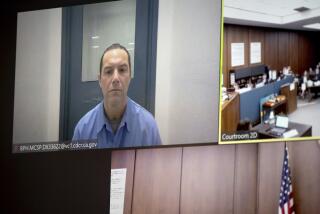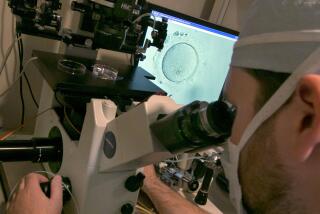Paternity Testing Is Not Just About Genetics but Trust and Fairness
- Share via
In 1999, a Texas man named Morgan Wise underwent genetic testing to determine whether he was a carrier of cystic fibrosis, a disease afflicting his youngest son. The test found that Wise was not a carrier. But the test also revealed something that threw Wise’s world into turmoil. He was not, in all likelihood, the child’s father. A paternity test proved that he wasn’t. And it also proved that he was not the father of two other children born during his marriage, which had ended in 1996. Only the eldest child was his biologically.
Wise took the genetic evidence to court, requesting the right to stop paying child support for the children who were not his biologically. The court refused and also decided to eliminate his visitation rights.
Experts say it is difficult to know how common Wise’s situation is because labs conducting paternity tests often do not know the details of a client’s situation. But according to medical researchers, there is a 5% to 10% chance that a child’s presumed father is not his or her biological father, a statistic that cuts across race and income levels.
Paternity testing, which involves taking a blood test or a swab from the inside of one’s cheek, has exploded over the last decade, evolving from medical tissue testing to the finely honed DNA test it is today. Roughly 280,000 paternity tests were conducted in 1999, three times as many as a decade earlier, according to the American Assn. of Blood Banks. In about 30% of the cases, the man tested was determined not to be the father of a child in question, the blood bank association found. The test has a 99.9% accuracy rate (half of a child’s genes must match the mother’s and half the father’s), meaning there is a less than one-tenth of 1% chance that a man who is a match is not the father.
*
About a third of American children are now born outside of marriage, and the surge in paternity testing can be attributed to that number, said Paula Roberts, a senior staff attorney at the Center for Law and Social Policy, a nonprofit organization specializing in issues that affect low-income families.
Most cases involve a mother pursuing a father in order to collect child support, said Roberts. Before paternity tests were available, courts presumed children born in marriage were the husband’s children, said Roberts. For children born out of wedlock, the question of paternity was a “he said, she said” scenario, with no way to prove it.
“Throughout history, any kind of sexual relationship between a woman and man was much more costly to a woman because she would be pregnant and she would be raising a child,” said Hillard Kaplan, a University of New Mexico anthropologist. “But without the formal marital relationship, she had no way to prove a man was the father of a child and he would deny it. Now a man has a one-night stand, and, potentially, he can be identified as the father and held responsible.”
Children born out of wedlock will stand a better chance of getting the emotional and financial support they deserve from fathers because of paternity testing, say some. But paternity testing also may have an adverse effect on children born in marriages in which the husband may not be the biological father. “This has opened a Pandora’s box,” Roberts said. “The test now gives us the ability to test marital children as well nonmarital children. If there is no legal distinction between marital and nonmarital children, which is where the Supreme Court has been going, why should we assume that marital children are the children of their mother’s husband?”
*
The London School of Economics last year conducted a study on the topic of misattributed fatherhood. Researchers found that tests revealing misidentified fathers can have devastating effects, ranging from a man’s emotional and financial withdrawal from a child to acts of serious abuse. In an unpublished study, Kaplan and his colleague Jane Lancaster examined how the paternal certainty of 1,100 fathers affected their investment in a child’s college education.
“If fathers had suspicions that they were not the father, we found they invested less in their children’s college education than men who said they were sure of paternity,” said Kaplan.
Now fathers can put their suspicions to rest if they are willing. But some experts think it may be best to leave the genetic details alone. “I don’t think many husbands would voluntarily get a paternity test,” said Hillard. “I think that in most marriages, the trust is very important and most men will not take a paternity test lightly.”
In the world of public policy, there are two extreme schools of thought on the matter, said Roberts. “There are groups that say we should test all the fathers of all babies born,” she said, avoiding any potential for questions later, which could disrupt a child’s life and bond with his or her presumed father. “And there are people at the other end of the spectrum that say, ‘If you question the children of every marriage, you have undermined the trust base of marriage.’ ”
The middle ground is occupied by a group called the National Conference of Commissioners, which is pushing for legislation that would give American parents two years after a child is born to question paternity. “If neither one raises paternity, then that is the end of that,” said Roberts. “The paramount concern is the child because after age 2, the child has formed an attachment to the father.”
*
Birds & Bees is a weekly column on relationships and sexuality. Kathleen Kelleher is at [email protected].
More to Read
Sign up for Essential California
The most important California stories and recommendations in your inbox every morning.
You may occasionally receive promotional content from the Los Angeles Times.










